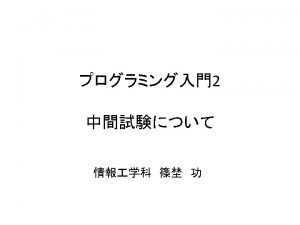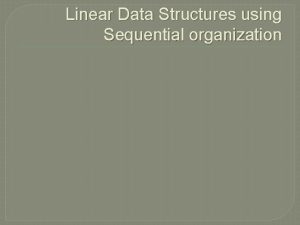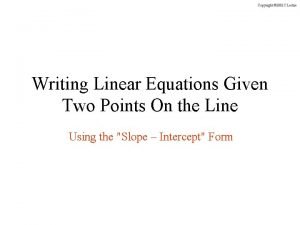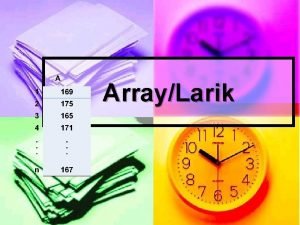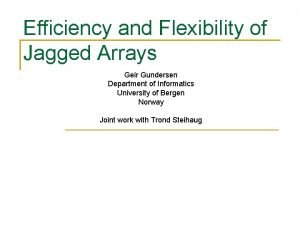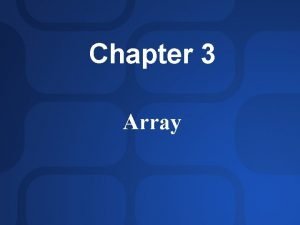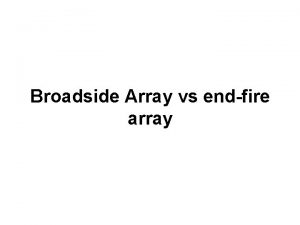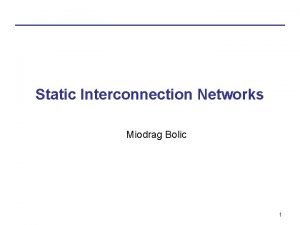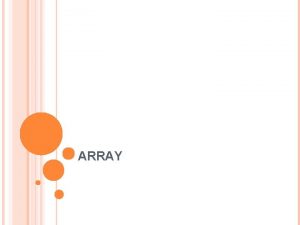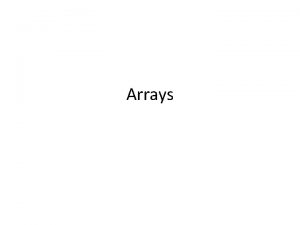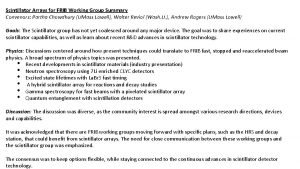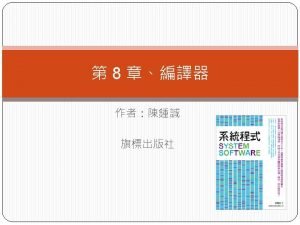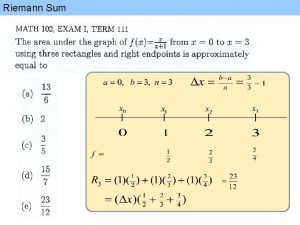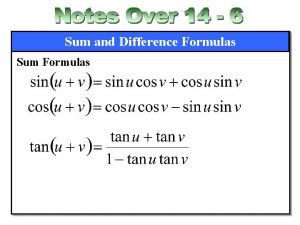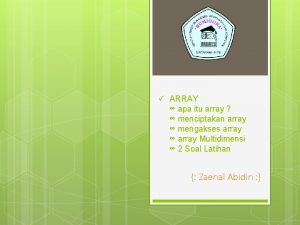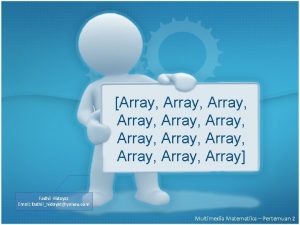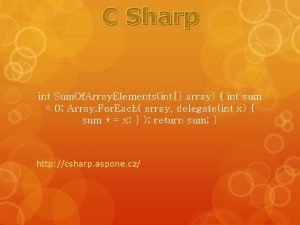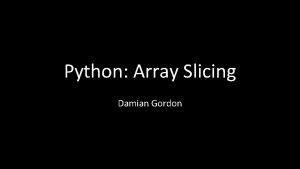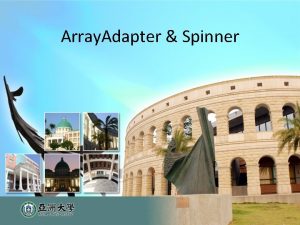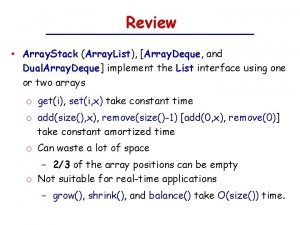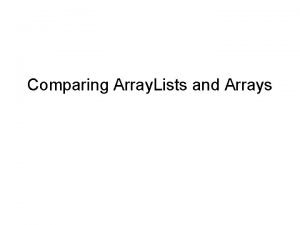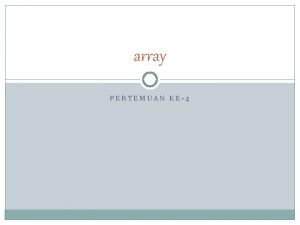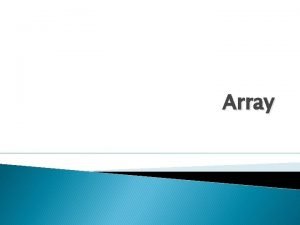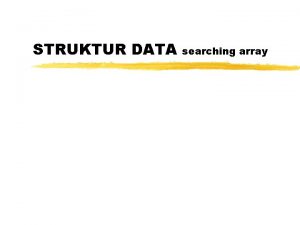Sum of a Linear Array Given an array


















- Slides: 18

Sum of a Linear Array • Given an array a = ( ai: i = 0, 1, …, n – 1 ), compute the sum of its elements: s = a 0 + a 1+…+ an – 1 • Elementary operations: – fetching ai from memory: n operations per array – addition: n – 1 operations per array Lecture 2 COMPSCI. 220. S 1. T - 2004 1

Sum of a Linear Array • Linear computing time: for n >> 1 T(n) c n • Factor c depends on the computer, operating system, programming language, compiler, etc • Linear relative changes: T(a n) = a T(n) Lecture 2 COMPSCI. 220. S 1. T - 2004 2

Sums of Contiguous Subsequences • Given an array (ai: i = 0, 1, …, n – 1) of size n =2 m, compute m + 1 sums: sk = ak + ak+1 + …+ a k+m– 1; k = 0, …, m of all contiguous subsequences of size m • Brute force computation: c m operations per subsequence; in total: c 3 Lecture 2 COMPSCI. 220. S 1. T - 2004 m (m + 1) operations

Sums of Contiguous Subsequences • Brute-force program (two nested loops): . . . int[ ] s = new int[ m + 1 ]; for( int k = 0; k <= m; k++ ) { // m + 1 sums s[ k ] = 0; for( int i = 0; i < m; i++ ) // each sum: c m COMPSCI. 220. S 1. T - 2004 Lecture 2 s[ k ] += a[ k + i ]; // 4

Brute-force Quadratic Approach • Quadratic time (two nested loops): • Quadratic relative changes: Lecture 2 COMPSCI. 220. S 1. T - 2004 5

Brute-force Quadratic Approach • Quadratic time complexity is due to reiterated computations in the innermost loop Lecture 2 COMPSCI. 220. S 1. T - 2004 6

Getting Linear Computing Time • Exclude reiterated computations of the “brute-force” algorithm: • As a result, the linear computing time: Lecture 2 COMPSCI. 220. S 1. T - 2004 7

Getting Linear Computing Time • Better program (two successive loops): . . . int[ ] s new int[ m + 1 ]; s[ 0 ] 0; for( int i 0; i < m; i++ ) // first sum: m operations s[ 0 ] + a[ i ]; for( int k = 1; k <= m; k++ ) // 2 operations per sum s[ k ] = s[ k – 1 ] + a[ k + m – 1] - a[ k – Lecture 2 COMPSCI. 220. S 1. T - 2004 8 1 ];

Computing Time for T(1)=1 ms Array size n Size / number of subsequences Brute-force (quadratic) algorithm Efficient (linear) algorithm Lecture 2 2, 000, 000 m / 1, 000, 000 m + 1 1, 001 / 1, 000, 001 T(n) 2 s > 23 days T(n) 1. 5 ms COMPSCI. 220. S 1. T - 2004 1. 5 s 9

Practical Usage: Data Averaging Data smoothing in a moving 1 D window: Lecture 2 COMPSCI. 220. S 1. T - 2004 10

Data Averaging Window size: m { 2, 3, …, n/2 } Partial sums: Sk = a 0 +. . . + ak Brute-force approach: T(n) c · m · n C · n 2 if m is a fraction of n Brute-force computing time might be even cubic: T(n) C · n 3 when the averaged data should COMPSCI. 220. S 1. T be compared for many 11 Lecture 2 - 2004 windows 2 m n/

Faster Data Averaging • Sequential modification of the current sum: T(n) m + 2·(n - m) per window (m n/2 ) • An extra memory for storing n partial sums Sk = a 0+a 1+…+ak; k = 0, 1, …, n-1 Lecture 2 2004 12 allows to find. COMPSCI. 220. S 1. T the sum- of each

Estimating Running Time • Simplifying assumptions: – all elementary statements / expressions take the same amount of time to execute • e. g. , simple arithmetic assignments • return • Loops increase in time linearly as k Tbody of a loop where k is number of times the loop is executed Lecture 2 COMPSCI. 220. S 1. T - 2004 13

Estimating Running Time • Conditional / switch statements are more complicated (because it is necessary to account for frequencies of branches) • Function calls: Tfunction = S Tstatements in function • Function composition: T(f(g(n))) = T(g(n))+T(f(n)) Lecture 2 COMPSCI. 220. S 1. T - 2004 14

Estimating Running Time • Function calls: T = S Tstatement . . . ){ i . . . x. my. Method( y, . . . ); public void my. Method( int a, statements 1, 2, …, N } • Function composition T(f(g(n))) Computation of x = g(n) T(g(n)) Lecture 2 COMPSCI. 220. S 1. T - 2004 Computation of y = f(x) T(f(n)) 15

Time to Sum Contiguous Sequences • Ignore data initialisation code • “Brute-force” nested loops: T(n) = m · (m +1) = n/2 · ( n/2 + 1 ) = 0. 25 n 2 + 0. 5 n • For a large n, T(n) 0. 25 n 2 – e. g. , if n > 500, 0. 5 n < 0. 4% of T(n) Lecture 2 COMPSCI. 220. S 1. T - 2004 16

Time to Sum Contiguous Sequences • Factor c = 0. 25 is referred to as a “constant of proportionality” • This factor does not effect the behaviour of the algorithm for a large n: – 10% increase in n leads to a 20% increase in T(n) Lecture 2 COMPSCI. 220. S 1. T - 2004 17

Quadratic vs linear time n 10 50 100 500 1000 Lecture 2 T(n) = 0. 25 n 2 + 0. 5 n T(n) 0. 25 n 2 0. 5 n 30 25 5 16. 7% 650 625 25 3. 8% 2550 2500 50 2. 0% 62750 62500 250 0. 4% 250500 250000 500 0. 2% COMPSCI. 220. S 1. T - 2004 18
 Sum0
Sum0 Given p(x)=3x² -x-4.sum of zeros is
Given p(x)=3x² -x-4.sum of zeros is Column major wise formula
Column major wise formula How to find the y intercept of two points
How to find the y intercept of two points Photovoltaic array maximum power point tracking array
Photovoltaic array maximum power point tracking array Tugascout
Tugascout Larik adalah
Larik adalah Jagged array vs multidimensional array
Jagged array vs multidimensional array Upper triangular array adalah
Upper triangular array adalah Associative array vs indexed array
Associative array vs indexed array Perbedaan array 1 dimensi dengan array 2 dimensi
Perbedaan array 1 dimensi dengan array 2 dimensi Pin grid array
Pin grid array Comparison between broadside array and endfire array
Comparison between broadside array and endfire array Scintillator detector
Scintillator detector Diameter of linear array is
Diameter of linear array is Representation of linear array in data structure
Representation of linear array in data structure Array linear dapat disebut juga …
Array linear dapat disebut juga … Traversing algorithm in array
Traversing algorithm in array Scintillator linear array
Scintillator linear array
